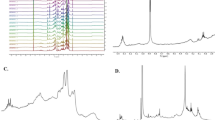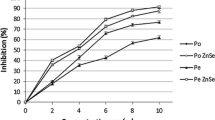Abstract
To investigate the effects of selenium on the main active components of Cordyceps militaris fruit bodies, selenium-enriched cultivation of C. militaris and the main active components of the fruit bodies were studied. Superoxide dismutase (SOD) activity and contents of cordycepin, cordycepic acid, and organic selenium of fruit bodies were sodium selenite concentration dependent; contents of adenosine and cordycep polysaccharides were significantly enhanced by adding sodium selenite in the substrates, but not proportional to sodium selenite concentrations. In the cultivation of wheat substrate added with 18.0 ppm sodium selenite, SOD activity and contents of cordycepin, cordycepic acid, adenosine, cordycep polysaccharides, and total amino acids were enhanced by 121/145%, 124/74%, 325/520%, 130/284%, 121/145%, and 157/554%, respectively, compared to NS (non-selenium-cultivated) fruit bodies and wild Cordyceps sinensis; organic selenium contents of fruit bodies reached 6.49 mg/100 g. So selenium-enriched cultivation may be a potential way to produce more valuable medicinal food as a substitute for wild C. sinensis.



Similar content being viewed by others
References
Das, S. K., Masuda, M., Sakurai, A., & Sakakibara, M. (2010). Medicinal uses of the mushroom Cordyceps militaris: Current state and prospects. Fitoterapia, 81, 961–968.
Khan, M. A., Tania, M., Zhang, D., & Chen, H. C. (2010). Cordyceps mushroom: A potent anticancer nutraceutical. Open Nutrition Journal, 8, 179–183.
Zhang, A. L., Lu, J. H., Zhang, N., Zheng, D., Zhang, G. R., & Teng, L. R. (2010). Extraction, purification and anti-tumor activity of polysaccharide from mycelium of mutant Cordyceps militaris. Chemical Research in Chinese Universities, 26, 798–802.
Chen, C., Luo, S. S., Li, Y., Sun, Y. J., & Zhang, C. K. (2004). Study on antioxidant activity of three Cordyceps sp. by chemiluminescence. Shanghai Journal of Traditional Chinese Medicine, 38, 53–55. in Chinese.
Shih, I. L., Tsai, K. L., & Hsieh, C. (2007). Effects of culture conditions on the mycelial growth and bioactive metabolite production in submerged culture of Cordyceps militaris. Biochemical Engineering Journal, 33, 193–201.
Ahn, Y. J., Park, S. J., Lee, S. G., Shin, S. C., & Choi, D. H. (2000). Selective growth inhibitor derived from liquid culture of Cordycceps militaris against Clostridium spp. Journal of Agriculture and Food Chemistry, 48, 2744–2748.
Kodama, E. N., McCaffrey, R. P., & Yusa, K. (2000). Antileukemic activity and mechanism of action of cordycepin against terminal deoxynucleotidyl transferase-positive (TdT+) leukemic cells. Biochemical Pharmacology, 59, 273–281.
Nan, J. X., Park, E. J., Yang, B. K., Song, C. H., Ko, G., & Sohn, D. H. (2001). Antibiotic effect of extracellular biopolymer from submerged mycelial cultures of Cordyceps militaris on liver fibrosis induced by bile duct ligation and scission in rats. Archives of Pharmacal Research, 24, 327–332.
Choi, S. B., Park, C. H., Choi, M. K., Jun, D. W., & Park, S. (2004). Improvement of insulin resistance and insulin secretion by water extracts of Cordyceps militaris, Phellinus linteus, and Paecilomyces tenuipes in 90% pancreatectomized rats. Bioscience, biotechnology and biochemistry, 68, 2257–2264.
Jung, K., Kim, I. H., & Han, D. (2004). Effect of medicinal plant extracts on forced swimming capacity in mice. Journal of Ethnopharmacology, 93, 75–81.
Kaczka, E. A., Trenner, N. R., Arison, B., Walker, R. W., & Folkers, K. (1964). Identification of cordycepin, a metabolite of Cordyceps militaris, as 3′-deoxyadenosine. Biochemical and Biophysical Research Communications, 14, 456–457.
Huang, L. F., Guo, F. Q., Liang, Y. Z., & Cheng, B. M. (2004). Determination of adenosine and cordycepin in Cordyceps sinensis and Cordyceps militaris with HPLC-ESIMS. China J Chinese Mater Med, 29, 762–764 (in Chinese).
Tara, F., Rayman, M. P., & Boskabadi, H. (2010). Prooxidant-antioxidant balance in pregnancy: A randomized double-blind placebo-controlled trial of selenium supplementation. Journal of Perinatal Medicine, 38, 473–478.
Ramoutar, R. R., & Brumaghim, J. L. (2010). Antioxidant and anticancer properties and mechanisms of inorganic selenium, oxo-sulfur, and oxo-selenium compounds. Cell Biochemistry and Biophysics, 58, 1–23.
Chun, J. Y., Nadiminty, N., Lee, S. O., Onate, S. A., Lou, W., & Gao, A. C. (2006). Mechanisms of selenium down-regulation of androgen receptor signaling in prostate cancer. Molecular Cancer Therapeutics, 5, 913–918.
Uden, P. C., Boakye, H. T., Kahakachchi, C., Hafezi, R., Nolibos, P., Block, E., Johnson, S., & Tyson, J. F. (2003). Element selective characterization of stability and reactivity of selenium species in selenized yeast. Journal of Analytical Atomic Spectrom, 18, 1–10.
Yu, T. T., & Qian, H. (2006). Effect of selenium on the chemical components of Cordyceps militaris. Food Science and Technology, 1, 133–135 (in Chinese).
Cui, J. D., & Zhang, B. Z. (2011). Comparison of culture methods on exopolysaccharide production in the submerged culture of Cordyceps militaris and process optimization. Letters in Applied Microbiology, 52, 123–128.
Yu, H. M., Wang, B. S., Huang, S. C., & Duh, P. D. (2006). Comparison of protective effects between cultured Cordyceps militaris and natural Cordyceps sinensis against oxidative damage. Journal of Agriculture and Food Chemistry, 54, 3132–3138.
Zheng, L. P., Gao, L. W., & Zhou, J. Q. (2008). Antioxidant activity of aqueous extract of a Tolypocladium sp. fungus isolated from wild Cordyceps sinensis. African Journal of Biotechnology, 7, 3004–3010.
Wong, Y. Y., Moon, A., Duffin, R., Barthet-Barateig, A., Meijer, H. A., Clemens, M. J., & Moor, C. H. (2010). Cordycepin inhibits protein synthesis and cell adhesion through effects on signal transduction. Journal of Biological Chemistry, 285, 2610–2621.
Kredich, N. M., & Guarino, A. J. (1961). Studies on the biosynthesis of cordycepin. Biochimica et Biophysica Acta, 47, 529–534.
Ulusu, N. N., & Turan, B. (2005). Beneficial effects of selenium on some enzymes of diabetic rat heart. Biological Trace Element Research, 3, 207–215.
Acknowledgments
This research was partially funded by the Doctor Research Project (498012) of the Hubei University for Nationalities and by the Ethnological Affair Committee Foundation of China (grant no. 10HB02). We are grateful to anonymous reviewers and the scientific editor for critical review and valuable suggestions and to Shengfeng Medicine Ltd. (Enshi, China) for their help in some experiments.
Author information
Authors and Affiliations
Corresponding authors
Additional information
Practical applications
C. militaris is widely used as a nutraceutical in functional foods or a phytopharmaceutical for treating some serious illnesses; selenium, a newly discovered anticancer element in recent years, can significantly enhance the anticancer activity of functional foods. However, most areas of the earth lack selenium. Selenium-enriching cultivation can significantly enhance contents of organic selenium and cordycepin in C. militaris fruit bodies. This study showed a potential method to produce selenium-enriched C. militaris fruit bodies with higher medicinal value than the commonly used wild C. sinensis, selenium supplementation of food and a primary source of cordycepin which had been reported to have great potential as an anticancer compound. The results also suggested a potential way for liquid fermentation to produce selenium-enriched C. militaris products, especially to enhance cordycepin production.
Rights and permissions
About this article
Cite this article
Dong, J.Z., Lei, C., Ai, X.R. et al. Selenium Enrichment on Cordyceps militaris Link and Analysis on Its Main Active Components. Appl Biochem Biotechnol 166, 1215–1224 (2012). https://doi.org/10.1007/s12010-011-9506-6
Received:
Accepted:
Published:
Issue Date:
DOI: https://doi.org/10.1007/s12010-011-9506-6




